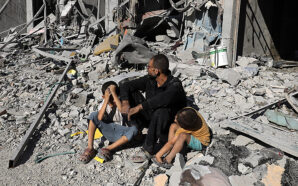In mid-April of last year, the Illinois chapter of the Patrons of the Arts in the Vatican Museums and Holy Name Cathedral of the Archdiocese of Chicago jointly sponsored the first annual Bishop Kevin Birmingham Lecture. Bishop Birmingham’s episcopal motto was “Tend My People.” This first lecture explored the intersection of art and tending God’s people with the theme: “Sharing the Stories of Migrants through Art.” The main presenter was an artist named Sr. Norma Pimentel, MJ.
Sr. Norma’s work with migrants in the Rio Grande Valley held the close attention of about two hundred people. She told her audience that the evening provided a unique opportunity for her to bring together two great passions of her life: her work with the marginalized poor and her art.
Sr. Norma, whose mother was also an artist, trained as a painter and planned to follow that path. Then, at a certain point, she moved toward religious life. Her entrance into a religious community seemed to pause her involvement in art. Her studies in social work and counseling led her to the amazingly effective ministry to migrants for which she is internationally recognized.
More recently, Sr. Norma has once again taken up her palette. She paints pictures of the people she serves, especially the women and children. A sample of these portraits was on display on either side of her as she spoke last year in Chicago. It struck me that these pictures formed a kind of iconostasis of the lowly ones who populate the kingdom. Particularly powerful was a portrait of a young migrant boy. Sr. Norma described how his eyes captivated her. Indeed, his young eyes seem to radiate many experiences, from weariness to caution to some measured hope.
Sr. Norma spoke very simply of the migrant experience and of her work with migrants. Her words communicated the needs not of a political or sociological category but of living, breathing individuals. As she related some of her experiences with migrants, her paintings seemed to bring them onstage. Sr. Norma’s whole presentation raised an important question that I have been reflecting on ever since: How should art relate to social engagement? Three functions of art seem especially important in this relationship: expression, teaching, and mobilization.
All good art expresses something: it catches and reveals an experience. This is certainly true of Sr. Norma’s paintings. Standing in front of one of her pictures, one catches a glimpse of the complex experience of migrants. But there is also something more at work here. The picture did not just offer me a glimpse of someone else’s experience; it seemed to draw me into that experience. This same dynamic is at work in the iconography of the Eastern Christian tradition. More than just representing someone or something, icons engage viewers, draw them in. Similarly, Sr. Norma’s paintings are windows through which we enter a world that transcends our own personal experience.
Her words communicated the needs not of a political or sociological category but of living, breathing individuals.
In addition to expressing an experience, art also teaches us how to notice things we might otherwise pass over. Saving us from drowning in a flood of sensory experience, art teaches us how to look at something with focused attention and thereby see what we might have overlooked. I have long had a notional grasp that migrants have come to us looking for safety and a better life. But it has been difficult for me to really see their complex struggles and aspirations. When I look at Sr. Norma’s portrait of a mother and child, the painting itself, reflecting the vision of the painter, teaches me how to see these two people, how to notice what makes them who they are. In this context, I am reminded of the idea of haecceitas or “this-ness,” first proposed by Duns Scotus and later taken up by the poet Gerard Manley Hopkins. Sr. Norma’s art teaches me to move beyond categories of people, like “the migrants,” to see the specificity of this person, who is unlike any other.
Finally, art has the capacity to mobilize us. Having entered a particular experience expressed in art, and having learned to see in a new way, we find ourselves changed, ready to live and act in a new way. Of course, bad art can serve as propaganda, but propaganda is a superficial stirring of emotions that prepares us to carry out someone else’s designs. The genuine mobilization effected by art leads to a free decision to act. Hence the power of Sr. Norma’s paintings: they do not cloud our vision with sentimentality or false nostalgia. Instead, they quietly invite us to know the migrant experience in a deeper way, and then to do something with our new knowledge.
Art can foster a genuine conversion, a turning around of mind and heart. When that happens, it may naturally lead to social commitments. Sr. Norma Pimentel’s portraits of migrants do exactly that. They replace general notions about migration with the specificity of particular migrants and nudge us toward deeper level of engagement.
Reproduced with permission by Commonweal.








